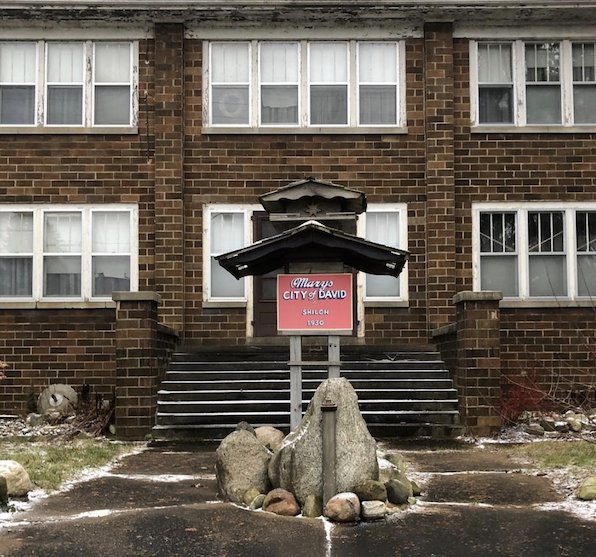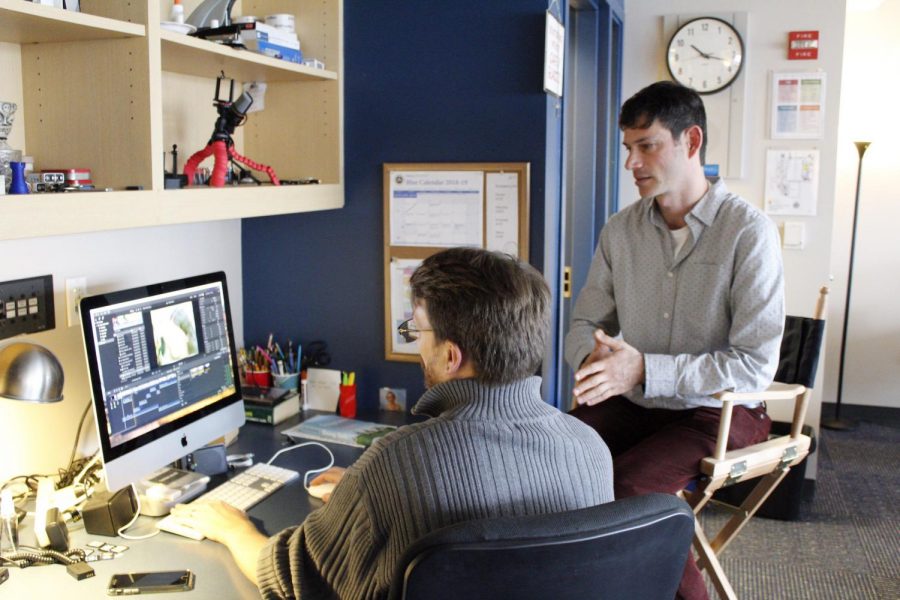Photo credit: Anna Fuder
High school teachers Travis Chandler and Dan Greenstone editing a documentary they are making.
Creating “Last Believer”
Greenstone and Chandler Collaborate on Documentary about Single Member of Declining Religious Sect
While teaching their first-ever semester of “Creating Historical Documentaries,” Upper School history teacher Dan Greenstone pitched an idea to visual arts teacher Travis Chandler. Greenstone, who had previously written and hosted a podcast on the Oneida religious commune, learned about another, Mary’s City of David, through his reporting. And it seemed like a fascinating subject for a documentary.
Like their students, the duo decided to start their own project. “We were helping the students make their films,” Chandler said, “and we thought, ‘heck, what better way to be able to teach them better than to try it ourselves?’”
The almost year-long process began with research—mostly by reading old newspaper accounts and exploring the archives at Hamilton College, where professors had studied Mary’s City of David, according to Greenstone. Then, a few times the over the summer and in the fall, Greenstone and Chandler made the two-hour drive to the commune’s campus in Benton Harbor, Michigan, for footage.
The 140-acre campus is expansive, with dozens of beige, brick houses, field space, a chicken coop, an out-of-commission bakery, and an auditorium. And it’s home to one resident: the 79-year-old Ron Taylor, the single living member of Mary’s City of David. He’s the subject of the film, explaining its title, “Last Believer.”

Mary’s City of David, in Benton Harbor, MI, separated from the Israelite House of David
When Greenstone and Chandler first sat with Taylor for an interview, they realized that their initial technique didn’t capture his personality. “He’s highly energetic and handy, and has sort of a hyperactivity,” Greenstone said, “so we found we were getting more interesting footage when he was giving us tours than when he was sitting down.”
As a result, the filming process was much more dynamic than Greenstone and Chandler had expected. “We ended up chasing this old man around the compound—he’s spry and quite healthy—and it wasn’t easy,” Chandler said. “It made my job challenging to get these shots to look good while he’s doing crazy construction and stuff, but it did make for a very visually interesting film.”
Around the compound, Taylor spends his days focusing on maintenance: repairing roofs, ensuring the plumbing is functional, blacksmithing, and using his carpentry skills to build furniture. He has to keep the campus livable, because, according to the Mary’s City of David ideology, 144,000 people will congregate there for the “Gathering”—when the world comes to an end, this group selected by God will achieve immortality and repopulate the Earth.
Mary’s City of David was founded in 1930 by Mary Purnell, though its parent society, the Israelite House of David, was established across the street 27 years before by Purnell and her husband, Benjamin Purnell. In the early 1900s, the Israelite House of David thrived with around a thousand members, a successful baseball team that gained national recognition, and a vibrant cultural scene revolving around its jazz orchestra.
Later though, in the 1920s, it came to light that Benjamin Purnell molested many of the young women on campus. The controversy was the main contributor to the subsequent split of Mary’s City of David from the Israelite House of David, which only has a handful of members today.
The decline in the population of both societies can be attributed to a few factors, according to Greenstone. First, of course, the sex scandal brought negative publicity that hindered recruitment efforts. In addition, the restrictive lifestyles carried out by members, which entailed celibacy and prohibited consumption of tobacco and alcohol, coupled with their untrue prophecies, diminished the appeal to join either sect. For example, the Israelite House of David incorrectly predicted that the world would end in 1906 and 1917.
Regardless, Taylor still holds his faith. “He is a very charming, very interesting, smart, fascinating human with what, by modern standards, would be considered to be a very complex, baffling set of beliefs,” Chandler said. “The more we talked to him, the more it became apparent that they’re no more baffling than other groups’ beliefs. The documentary is a little bit of an examination of faith itself, and we hope viewers find empathy with him.”
Music teacher Alec Synakowski, who’s had a passion for flying since he was a kid, once traveled to Benton Harbor with Greenstone and Chandler to record drone footage of the campus. He noticed the way Taylor expressed himself through his “fantastical” drawings and paintings.
“Ron’s idiosyncrasies come out through his art. He has a lot of understandings about the world you wouldn’t get by just talking to him,” Synakowski said. “He would just seem like an old man with a beard if you saw him at a gas station. Ron seems quirky, yet relatable.”
Synakowski appreciated contributing to the documentary. He said, “It was really exciting to have a history teacher, an art teacher, and a music teacher just take off on the weekend and have a really interesting collaborative project.”

Ron Taylor is the sole resident of this house, and works to maintain the campus.
Greenstone and Chandler both mentioned how well they worked together throughout the process. “I’ve been more focused on the technical side, while Dan is more focused on the research and interviewing,” Chandler said. His experience working on documentary series such as PBS’s “Retirement Revolution” and “The First 48,” a crime drama, prepared him to piece together the footage and create the film’s music. “Generally speaking, those are our realms of expertise. We joke about it — at the beginning, he was much busier than I was, and now, I’m much busier than he is.”
Making their own historical documentary has proved useful in instructing students. “All of a sudden, instead of it being ‘here’s how to fix what you messed up,’” Chandler said, “it became, ‘I messed that up last week, here’s the best way to get out of that situation.’”
The duo plans to send their finished product to some film festivals and possibly show it for the Parker community. They’ve also started a new project, but the subject is under wraps.
“I’m terrible at the beach—I get bored real quick. I’d rather be making something, or learning something,” Greenstone said. “The world’s a big, interesting place. If you ask someone to tell you about their corner of it, they’re generally happy to do it.”
